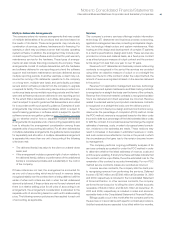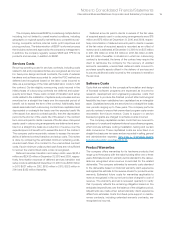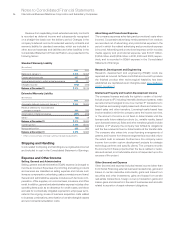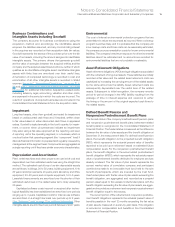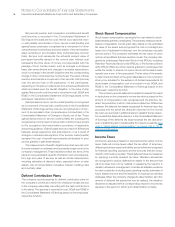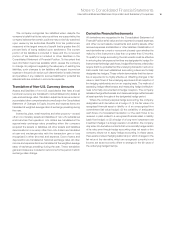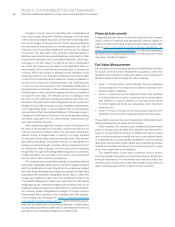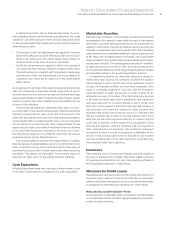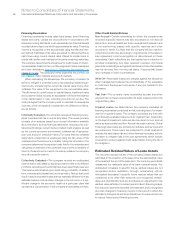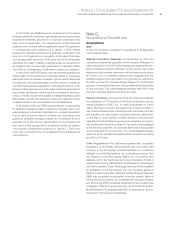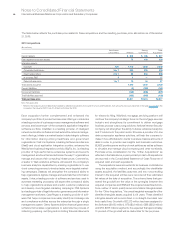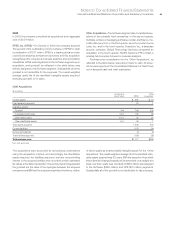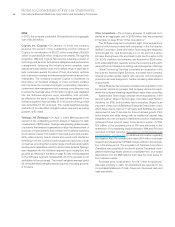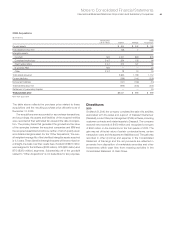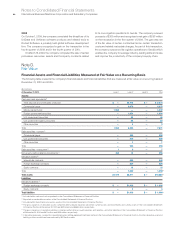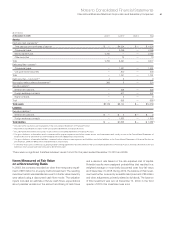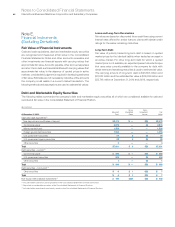IBM 2010 Annual Report Download - page 81
Download and view the complete annual report
Please find page 81 of the 2010 IBM annual report below. You can navigate through the pages in the report by either clicking on the pages listed below, or by using the keyword search tool below to find specific information within the annual report.
Notes to Consolidated Financial Statements
International Business Machines Corporation and Subsidiary Companies 79
Common Stock
Common stock refers to the $.20 par value per share capital stock
as designated in the company’s Certificate of Incorporation.
Treasury stock is accounted for using the cost method. When
treasury stock is reissued, the value is computed and recorded
using a weighted-average basis.
Earnings Per Share of Common Stock
Earnings per share (EPS) is computed using the two-class method.
The two-class method determines EPS for each class of common
stock and participating securities according to dividends and
dividend equivalents and their respective participation rights in
undistributed earnings. Basic EPS of common stock is computed
by dividing net income by the weighted-average number of common
shares outstanding for the period. Diluted EPS of common stock is
computed on the basis of the weighted-average number of shares
of common stock plus the effect of dilutive potential common shares
outstanding during the period using the treasury stock method.
Dilutive potential common shares include outstanding stock options,
stock awards and convertible notes. See note R, “Earnings Per Share
of Common Stock,” on page 108 for additional information.
Note B.
Accounting Changes
New Standards to be Implemented
In December 2010, the Financial Accounting Standards Board
(FASB) issued amended guidance to clarify the acquisition date
that should be used for reporting pro-forma financial information
for business combinations. If comparative financial statements are
presented, the pro-forma revenue and earnings of the combined
entity for the comparable prior reporting period should be reported
as though the acquisition date for all business combinations that
occurred during the current year had been completed as of the
beginning of the comparable prior annual reporting period. The
amendments in this guidance are effective prospectively for business
combinations for which the acquisition date is on or after January
1, 2011. There will be no impact in the consolidated financial results
as the amendments relate only to additional disclosures.
In December 2010, the FASB issued amendments to the guid-
ance on goodwill impairment testing. The amendments modify
Step 1 of the goodwill impairment test for reporting units with zero
or negative carrying amounts. For those reporting units, an entity
is required to perform Step 2 of the goodwill impairment test if it
is more likely than not that a goodwill impairment exists. In making
that determination, an entity should consider whether there are
any adverse qualitative factors indicating that an impairment may
exist. The amendments are effective for fiscal years and interim
periods beginning January 1, 2011 and are not expected to have
a material impact in the Consolidated Financial Statements.
Standards Implemented
In July 2010, the FASB issued amendments to the disclosure
requirements about the credit quality of financing receivables and
the allowance for credit losses. The purpose of the additional
disclosures is to enable users of financial statements to better
understand the nature of credit risk inherent in an entity’s portfolio
of financing receivables and how that risk is analyzed. For end-of-
period balances, the new disclosures are required to be made in
all interim and annual periods ending on or after December 15,
2010. See Note G, “Financing Receivables,” on pages 90 to 92
and Note A, “Significant Accounting Policies,” on page 78 for the
company’s disclosures. For activity during a reporting period, the
disclosures are required to be included in all interim and annual
periods after January 1, 2011. In January 2011, the FASB issued an
amendment deferring the disclosures regarding troubled debt
restructurings until such time as new guidance on this topic is issued.
These changes did not have an impact in the consolidated financial
results as this guidance only relates to additional disclosures.
In January 2010, the FASB issued additional disclosure require-
ments for fair value measurements. According to the guidance, the
fair value hierarchy disclosures should be disaggregated by class
of assets and liabilities. A class is often a subset of assets or
liabilities within a line item in the statement of financial position. In
addition, significant transfers between Levels 1 and 2 of the fair
value hierarchy are required to be disclosed. These additional
requirements became effective January 1, 2010 for quarterly and
annual reporting. These amendments did not have an impact in
the consolidated financial results as this guidance relates only to
additional disclosures. See Note D, “Fair Value,” on pages 86 and
87 for the company’s disclosures. The guidance also requires more
detailed disclosures of the changes in Level 3 instruments. These
changes became effective January 1, 2011 and are not expected
to have an impact in the consolidated financial results as they
relate only to additional disclosures.
In October 2009, the FASB issued amended revenue recogni-
tion guidance for arrangements with multiple deliverables. The
new guidance requires the use of management’s BESP for the
deliverables in an arrangement when VSOE, vendor objective
evidence (VOE) or TPE of the selling price is not available. In
addition, excluding specific software revenue recognition guidance,
the residual method of allocating arrangement consideration is no
longer permitted, and an entity is required to allocate arrangement
consideration using the relative selling price method. In accordance
with the guidance, the company elected to early adopt its provi-
sions as of January 1, 2010 on a prospective basis for all new or
materially modified arrangements entered into on or after that date.
The adoption of this guidance did not have a material impact in
the Consolidated Financial Statements.


